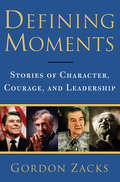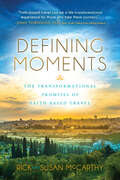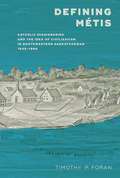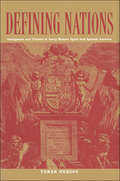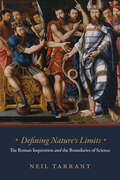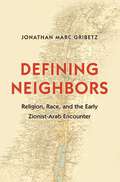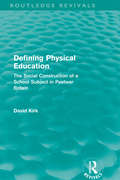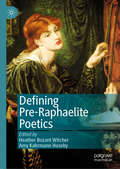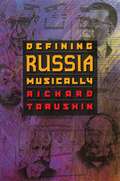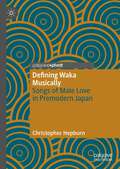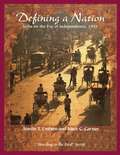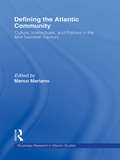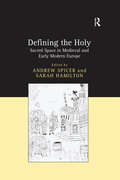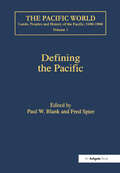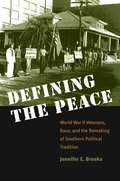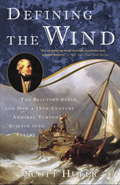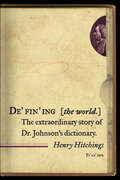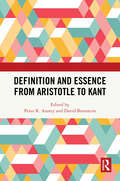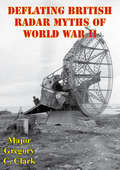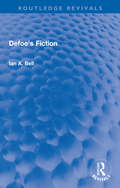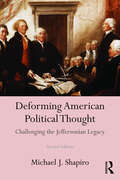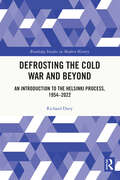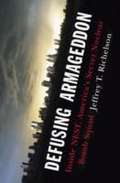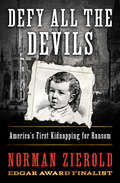- Table View
- List View
Defining Moments: Stories of Character, Courage and Leadership
by Gordon ZacksI was born the year Hitler came to power. There was no Israel. There was a Holocaust. Six million Jews were slaughtered for the crime of being born, and hardly a blip registered on the world's conscience. The world was indifferent-it pretended not to know. Israel was created in 1948, and I decided I wanted to be part of the rebirth of the Land and the redemption of the People of Israel. That has been my passion . . . and my purpose. That was my defining moment.I have had the privilege to work with some extraordinary and courageous people who taught me valuable lessons about leadership and life. These stories are first-hand accounts of how people-some famous, some not-followed their passion, lived their purpose, and aspired to be part of something greater than their selves. These people had the courage to seize their moment and make the world a better place, revealing valuable lessons on the path to a more rewarding life.
Defining Moments: The Transformational Promises of Faith-Based Travel
by Susan McCarthy Rick McCarthyA guide to faith-based, Spirit-led, heart-changing travel to the Holy Land and historic Christian sites throughout Europe.Travel is the one thing that makes you richer after you pay for it—and that’s especially true when itineraries are designed to provide a life-changing spiritual revelation experience. This guide is ideal for individuals and tour leaders who want to bring the Holy Spirit along on their journeys as they seek defining moments with God.Covering destinations such as Antioch, Bethlehem, Emmaus, Corinth, Canterbury, Zurich, and many more, Defining Moments not only allows you to follow in the footsteps of Paul’s missionary journeys or learn more about the Reformation, but deepens your experience in ways that can restore, revive, and re-energize your faith—turning travel into transformation. Also included are numerous practical tips about preparing for your trip, navigating unfamiliar places, touring with a group, and more.
Defining Métis: Catholic Missionaries and the Idea of Civilization in Northwestern Saskatchewan, 1845-1898
by Timothy P. Foran"Defining Métis" examines categories used in the latter half of the nineteenth century by Catholic missionaries to describe Indigenous people in what is now northwestern Saskatchewan. It argues that the construction and evolution of these categories reflected missionaries’changing interests and agendas. "Defining Métis" sheds light on the earliest phases of Catholic missionary work among Indigenous peoples in western and northern Canada. It examines various interrelated aspects of this work, including the beginnings of residential schooling, transportation and communications, and relations between the Church, the Hudson’s Bay Company, and the federal government. While focusing on the Oblates of Mary Immaculate and their central mission at Île-à-la-Crosse, this study illuminates broad processes that informed Catholic missionary perceptions and impelled their evolution over a fifty-three-year period. In particular, this study illuminates processes that shaped Oblate conceptions of sauvage and métis. It does this through a qualitative analysis of documents that were produced within the Oblates’ institutional apparatus – official correspondence, mission journals, registers, and published reports. Foran challenges the orthodox notion that Oblate commentators simply discovered and described a singular, empirically existing, and readily identifiable Métis population. Rather, he contends that Oblates played an important role in the conceptual production of les métis.
Defining Nations: Immigrants and Citizens in Early Modern Spain and Spanish America
by Tamar HerzogIn this book Tamar Herzog explores the emergence of a specifically Spanish concept of community in both Spain and Spanish America in the eighteenth century. Challenging the assumption that communities were the natural result of common factors such as language or religion, or that they were artificially imagined, Herzog reexamines early modern categories of belonging. She argues that the distinction between those who were Spaniards and those who were foreigners came about as local communities distinguished between immigrants who were judged to be willing to take on the rights and duties of membership in that community and those who were not.
Defining Nature's Limits: The Roman Inquisition and the Boundaries of Science
by Neil TarrantA look at the history of censorship, science, and magic from the Middle Ages to the post-Reformation era. Neil Tarrant challenges conventional thinking by looking at the longer history of censorship, considering a five-hundred-year continuity of goals and methods stretching from the late eleventh century to well into the sixteenth. Unlike earlier studies, Defining Nature’s Limits engages the history of both learned and popular magic. Tarrant explains how the church developed a program that sought to codify what was proper belief through confession, inquisition, and punishment and prosecuted what they considered superstition or heresy that stretched beyond the boundaries of religion. These efforts were continued by the Roman Inquisition, established in 1542. Although it was designed primarily to combat Protestantism, from the outset the new institution investigated both practitioners of “illicit” magic and inquiries into natural philosophy, delegitimizing certain practices and thus shaping the development of early modern science. Describing the dynamics of censorship that continued well into the post-Reformation era, Defining Nature's Limits is revisionist history that will interest scholars of the history science, the history of magic, and the history of the church alike.
Defining Nature's Limits: The Roman Inquisition and the Boundaries of Science
by Neil TarrantA look at the history of censorship, science, and magic from the Middle Ages to the post-Reformation era. Neil Tarrant challenges conventional thinking by looking at the longer history of censorship, considering a five-hundred-year continuity of goals and methods stretching from the late eleventh century to well into the sixteenth. Unlike earlier studies, Defining Nature’s Limits engages the history of both learned and popular magic. Tarrant explains how the church developed a program that sought to codify what was proper belief through confession, inquisition, and punishment and prosecuted what they considered superstition or heresy that stretched beyond the boundaries of religion. These efforts were continued by the Roman Inquisition, established in 1542. Although it was designed primarily to combat Protestantism, from the outset the new institution investigated both practitioners of “illicit” magic and inquiries into natural philosophy, delegitimizing certain practices and thus shaping the development of early modern science. Describing the dynamics of censorship that continued well into the post-Reformation era, Defining Nature's Limits is revisionist history that will interest scholars of the history science, the history of magic, and the history of the church alike.
Defining Neighbors: Religion, Race, and the Early Zionist-Arab Encounter (Jews, Christians, and Muslims from the Ancient to the Modern World #58)
by Jonathan Marc GribetzHow religion and race—not nationalism—shaped early encounters between Zionists and Arabs in PalestineAs the Israeli-Palestinian conflict persists, aspiring peacemakers continue to search for the precise territorial dividing line that will satisfy both Israeli and Palestinian nationalist demands. The prevailing view assumes that this struggle is nothing more than a dispute over real estate. Defining Neighbors boldly challenges this view, shedding new light on how Zionists and Arabs understood each other in the earliest years of Zionist settlement in Palestine and suggesting that the current singular focus on boundaries misses key elements of the conflict.Drawing on archival documents as well as newspapers and other print media from the final decades of Ottoman rule, Jonathan Gribetz argues that Zionists and Arabs in pre–World War I Palestine and the broader Middle East did not think of one another or interpret each other's actions primarily in terms of territory or nationalism. Rather, they tended to view their neighbors in religious terms—as Jews, Christians, or Muslims—or as members of "scientifically" defined races—Jewish, Arab, Semitic, or otherwise. Gribetz shows how these communities perceived one another, not as strangers vying for possession of a land that each regarded as exclusively their own, but rather as deeply familiar, if at times mythologized or distorted, others. Overturning conventional wisdom about the origins of the Israeli-Palestinian conflict, Gribetz demonstrates how the seemingly intractable nationalist contest in Israel and Palestine was, at its start, conceived of in very different terms.Courageous and deeply compelling, Defining Neighbors is a landmark book that fundamentally recasts our understanding of the modern Jewish-Arab encounter and of the Middle East conflict today.
Defining Physical Education: The Social Construction of a School Subject in Postwar Britain (Routledge Revivals)
by David KirkFirst published in 1992, David Kirk’s book analyses the public debate leading up to the 1987 General Election over the place and purpose of physical education in British schools. By locating this debate in a historical context, specifically in the period following the end of the Second World War, it attempts to illustrate how the meaning of school physical education and its aims, content and pedagogy were contested by a number of vying groups. It stresses the influence of the culture of postwar social reconstruction in shaping these groups’ ideas about physical education. Through this analysis, the book attempts to explain how physical education has been socially constructed during the postwar years and, more specifically, to suggest how the subject came to be used as a symbol of subversive, left wing values in the campaign leading to the 1987 election. In more general terms, the book provides a case study of the social construction of school knowledge. The book takes an original approach to the question of curriculum change in physical education, building on increasing interest in historical research in the field of curriculum studies. It adopts a social constructionist perspective, arguing that change occurs through the active involvement of competing groups in struggles over limited material and ideological (discursive) resources. It also draws on contemporary developments in social and cultural theory, particularly the concepts of discourse and ideological hegemony, to explain how the meaning of physical education has been constructed, and how particular definitions of the subject have become orthodoxes. The book presents new historical evidence from a period which had previously been neglected by researchers, despite the fact that 1945 marked a watershed in the development of the understanding and teaching of physical education in schools.
Defining Pre-Raphaelite Poetics
by Heather Bozant Witcher Amy Kahrmann HusebyDefining Pre-Raphaelite Poetics offers a range of Pre-Raphaelite literary scholarship, provoking innovative discussions into the poetic form, gender dynamics, political engagement, and networked communities of Pre-Raphaelitism. The authors in this collection position Pre-Raphaelite poetics broadly in the sense of poiesis, or acts of making, aiming to identify and explore the Pre-Raphaelites’ diverse forms of making: social, aesthetic, gendered, and sacred. Each chapter examines how Pre-Raphaelitism takes up and explores modes of making and re-making identity, relationality, moral transformations, and even, time and space. Essays explore themes of formalist or prosodic approaches, expanded networks of literary and artistic influence within Pre-Raphaelitism, and critical legacies and responses to Pre-Raphaelite poetry and arts, codifying the methods, forms, and commonalties that constitute literary Pre-Raphaelitism.
Defining Russia Musically: Historical and Hermeneutical Essays
by Richard TaruskinThe world-renowned musicologist Richard Taruskin has devoted much of his career to helping listeners appreciate Russian and Soviet music in new and sometimes controversial ways. Defining Russia Musically represents one of his landmark achievements: here Taruskin uses music, together with history and politics, to illustrate the many ways in which Russian national identity has been constructed, both from within Russia and from the Western perspective. He contends that it is through music that the powerful myth of Russia's "national character" can best be understood. Russian art music, like Russia itself, Taruskin writes, has "always [been] tinged or tainted ... with an air of alterity--sensed, exploited, bemoaned, reveled in, traded on, and defended against both from within and from without." The author's goal is to explore this assumption of otherness in an all-encompassing work that re-creates the cultural contexts of the folksong anthologies of the 1700s, the operas, symphonies, and ballets of the 1800s, the modernist masterpieces of the 1900s, and the hugely fraught but ambiguous products of the Soviet period. Taruskin begins by showing how enlightened aristocrats, reactionary romantics, and the theorists and victims of totalitarianism have variously fashioned their vision of Russian society in musical terms. He then examines how Russia as a whole shaped its identity in contrast to an "East" during the age of its imperialist expansion, and in contrast to two different musical "Wests," Germany and Italy, during the formative years of its national consciousness. The final section, expanded from a series of Christian Gauss seminars presented at Princeton in 1993, focuses on four individual composers, each characterized both as a self-consciously Russian creator and as a European, and each placed in perspective within a revealing hermeneutic scheme. In the culminating chapters--Chaikovsky and the Human, Scriabin and the Superhuman, Stravinsky and the Subhuman, and Shostakovich and the Inhuman--Taruskin offers especially thought-provoking insights, for example, on Chaikovsky's status as the "last great eighteenth-century composer" and on Stravinsky's espousal of formalism as a reactionary, literally counterrevolutionary move.
Defining Waka Musically: Songs of Male Love in Premodern Japan
by Christopher HepburnThis book considers how music, musicality, and ideologies of musicality are working within the specific construction of waka on the theme of male love in Kitamura Kigin’s Iwatsutsuji (1676) and Ihara Saikaku’s Nanshoku ōkagami (1687) by using a modified generative theory of music. This modified theory seeks to get at the interdependent meanings that may exist among the music, image, and the text of the waka in question. In all, this study guides the reader through five waka on the theme of male love and demonstrates not only how each waka is inherently musical but how the image and text may interdependently relate to the ways in which premodern Japanese song poets may not only have thought in and with sound but may have also utilized a diverse array of musical gestures to construct new objects of knowledge. In the case of this study, these new objects of knowledge seem to have aided in situating a changing musicopoetics that aligned with changing constructions of male desire.
Defining a Nation: India on the Eve of Independence 1945
by Mark Carnes Ainslie EmbreePart of the “Reacting to the Past” series, this text consists of a game in which students are assigned roles, informed by classic texts, set in a particular moment of intellectual and social ferment. The game is set at Simla, in the foothills of the Himalayas, where the British viceroy has invited leaders of various religious and political constituencies to work out the future of Britain's largest colony.
Defining the Atlantic Community: Culture, Intellectuals, and Policies in the Mid-Twentieth Century
by Marco MarianoIn this volume, essays by scholars from both sides of the Atlantic open new perspectives on the construction of the "Atlantic community" during World War II and the early Cold War years. Based on original approaches bringing together diplomatic history and the history of culture and ideas, the book shows how atlantism came to provide a solid ideological foundation for the security community of North American and European nations which took shape in the 1940s. The idea of a transatlantic community based on shared histories, values, and political and economic institutions was instrumental to the creation of the Atlantic Alliance, and partly accounts for the continuing existence of the Atlantic partnership after the Cold War. At the same time, this study breaks new ground by arguing that the emergence of the idea of "Atlantic community" also reflected deeper trends in transatlantic relations; in fact, it was the outcome of the re-definition of "the West" due to the rise of the US and the decline of Europe in the international arena during the first half of the Twentieth Century.
Defining the Holy: Sacred Space in Medieval and Early Modern Europe
by Sarah HamiltonHoly sites, both public - churches, monasteries, shrines - and more private - domestic chapels, oratories - populated the landscape of medieval and early modern Europe, providing contemporaries with access to the divine. These sacred spaces thus defined religious experience, and were fundamental to both the geography and social history of Europe over the course of 1,000 years. But how were these sacred spaces, both public and private, defined? How were they created, used, recognised and transformed? And to what extent did these definitions change over the course of time, and in particular as a result of the changes wrought in the sixteenth and seventeenth centuries. Taking a strongly interdisciplinary approach, this volume tackles these questions from the point of view of archaeology, architectural and art history, liturgy, and history to consider the fundamental interaction between the sacred and the profane. Exploring the establishment of sacred space within both the public and domestic spheres, as well as the role of the secular within the sacred sphere, each chapter provides fascinating insights into how these concepts helped shape, and were shaped by, wider society. By highlighting these issues on a European basis from the medieval period through the age of the reformations, these essays demonstrate the significance of continuity as much as change in definitions of sacred space, and thus identify long term trends which have hitherto been absent in more limited studies. As such this volume provides essential reading for anyone with an interest in the ecclesiastical development of western Europe from the thirteenth to the eighteenth centuries.
Defining the Pacific: Opportunities and Constraints (The Pacific World: Lands, Peoples and History of the Pacific, 1500-1900)
by Fred SpierThis volume lays the physical and conceptual groundwork for the Pacific World series, exploring both the constraints imposed and the opportunities offered to humanity by the physical environment of the Pacific region. Organized from the perspectives of "Big History" and macro-geography, the volume presents a series of major studies and surveys by authors from a range of disciplines. It opens with perspectives on the ocean, and closes with questions of human settlement, diffusion, and trans-Pacific contacts. Geologists write of the origins of the Pacific, its geological structure, and the problem of tsunamis; climatologists and oceanographers discuss the El Niño Southern Oscillation and the ocean waters; biologists and biogeographers find patterns in the life of the Basin - as is shown, all these have their impact on the potential of the region for human use and settlement. Finally, geographers, anthropologists, and archaeologists deal with the peopling of the Pacific islands, the settlement of the Americas, and the incidence and importance of pre-modern links across the Pacific.
Defining the Peace
by Jennifer E. BrooksIn the aftermath of World War II, Georgia's veterans--black, white, liberal, reactionary, pro-union, and anti-union--all found that service in the war enhanced their sense of male, political, and racial identity, but often in contradictory ways. In Defining the Peace, Jennifer E. Brooks shows how veterans competed in a protracted and sometimes violent struggle to determine the complex character of Georgia's postwar future. Brooks finds that veterans shaped the key events of the era, including the gubernatorial campaigns of both Eugene Talmadge and Herman Talmadge, the defeat of entrenched political machines in Augusta and Savannah, the terrorism perpetrated against black citizens, the CIO's drive to organize the textile South, and the controversies that dominated the 1947 Georgia General Assembly. Progressive black and white veterans forged new grassroots networks to mobilize voters against racial and economic conservatives who opposed their vision of a democratic South. Most white veterans, however, opted to support candidates who favored a conservative program of modernization that aimed to alter the state's economic landscape while sustaining its anti-union and racial traditions. As Brooks demonstrates, World War II veterans played a pivotal role in shaping the war's political impact on the South, generating a politics of race, anti-unionism, and modernization that stood as the war's most lasting political legacy.
Defining the Wind: The Beaufort Scale, and How a 19th-century Admiral Turned Science into Poetry
by Scott HulerA remarkable journey over land and sea into a fascinating world of explorers, mariners, scientists, and writers. Huler was so taken with the Beaufort Wind Scale that he went in search of Adm. Francis Beaufort himself: hydrographer to the British Admiralty, man of science, and author -- Huler assumed -- of the Beaufort Wind Scale. But the scale that carries Beaufort's name has a long and complex evolution, and to properly understand it means reaching farther back in history, into the lives and works of figures from Daniel Defoe and Charles Darwin to Captains Bligh and Cook. All around the world in the mid-18th and 19th century, modern science was being invented every day. A wonderfully readable story that is ultimately about how we observe the forces of nature and the world around us.
Defining the World: The Extraordinary Story of Dr. Johnson's Dictionary
by Henry Hitchings&“[A] marvelous account&” of Johnson&’s towering achievement, nearly a decade of labor and linguistic fact-finding, presented by &“a buoyant, zestful writer&” (The Boston Globe). By the early eighteenth century, France and Italy had impressive lexicons, but there was no authoritative dictionary of English. Impelled by a mixture of national pride and commercial expedience, the prodigious polymath Samuel Johnson embraced the task, turning over the garret of his London home to the creation of his own giant dictionary. Johnson imagined that he could complete the job in three years. But the complexity of English meant that his estimate was wildly inadequate. Only after he had expended nearly a decade of his prime on the task did the dictionary finally appear—magisterial yet quirky, dogmatic but generous of spirit, and steeped in the richness of English literature. It would come to be seen as the most important British cultural monument of the eighteenth century, and its influence fanned out across Europe and throughout Britain&’s colonies—including, crucially, America. Brilliantly entertaining and enlightening, Defining the World is the story of Johnson&’s heroic endeavor. In alphabetically sequenced chapters, Henry Hitchings describes Johnson&’s adventure—his ambition and vision, his moments of despair, the mistakes he made along the way, and his ultimate triumph.
Definition and Essence from Aristotle to Kant
by David Bronstein Peter R. AnsteyThis volume brings together 12 essays exploring the history of theories of definition and essence in Western philosophy from Aristotle to Kant. Definition and essence have been central to philosophical theorising since antiquity and remain so to this day. This volume presents a series of explorations of key authors and themes connected by a common set of questions: What are definitions and essences? What are the connections between them? What are their logical and metaphysical properties? What sorts of things have definitions and essences and what sorts of things do not? What functions do definitions and essences serve in the physical, mathematical, and human sciences? How, if at all, can we come to know them? This volume shows that answering these questions allows us to see in a new light key figures and movements in the history of Western thought. The volume’s broad historical sweep also facilitates comparisons between different figures. And it reveals important connections between different subfields of philosophy as these were developed over the centuries – logic, metaphysics, epistemology, philosophy of language, and natural philosophy among them.Definition and Essence from Aristotle to Kant will be of interest to scholars and graduate students working in the history of philosophy, history of logic, history of mathematics, epistemology, and metaphysics.
Deflating British Radar Myths Of World War II
by Major Gregory C. ClarkBritish and Allied memoirs and histories have contributed to the rise of three myths concerning the discovery and employment of radar. These myths are as follows. The first myth is that Sir Robert Watson-Watt is the father and sole inventor of radar. The second is that Germany's discovery and realization of radar's military worth occurred after 1940 following exposure to British systems. The third myth gives radar the pivotal role in the defeat of the Luftwaffe in the Battle of Britain.To deflate these myths the origin of radar is traced from James Maxwell's discovery of radio waves to early radar theorists and inventors. Their role in the story of radar illuminates and contributes to the deflation of the radar myths.Both the rebirth of the Luftwaffe and evolution of the R.A.F. during the 1920's and 1930's shows how each service independently arrived at the development of radar technology for different reasons. In 1939 Germany possessed some of the world's best and most enduring radar designs, as well as essential navigation and bombing aids. England's Chain Home radar was a dead end technology with serious shortcomings, but was skillfully melded to an innovative command and control system. The illumination of German radar achievements and a balanced analysis of British defensive systems essentially deflates the radar myths.
Defoe's Fiction (Routledge Revivals)
by Ian A. BellFirst published in 1985, Defoe’s Fiction explores Defoe’s work by considering it in the context of its genre. The book highlights the difficulty of placing Defoe’s fiction in the most appropriate context due to it being aimed primarily at a popular market, in contrast to the more literary productions of Pope, Swift, or Addison. It also comments on the trend of focusing on Defoe’s irony or emphasising his mimetic power. In doing so, it seeks to explain, rather than judge, Defoe’s achievement by looking at his whole body of work in the context of its genre. Defoe’s Fiction will appeal to those with an interest in Defoe, comparative literature, and the history of literary criticism.
Deforming American Political Thought: Challenging the Jeffersonian Legacy
by Michael J. ShapiroDeforming American Political Thought offers an alternative to the dominant American historical imagination, treating issues that range from the nature of Thomas Jefferson's vision of an egalitarian nation to the persistence of racial inequality. Presenting multifaceted arguments that transcend the myopic scope of traditional political discourses, Michael J. Shapiro summons disparate disciplines and genres – architecture, crime stories, novels, films, and jazz/blues music (among others) to provide approaches to the comprehension of diverse facets of American political thought from the founding to the present. The book’s various investigations disclose that there have always been dissenting voices, articulated in diverse genres of expression that cast doubt on the moral purpose and exceptionalism of the American mind. This highly anticipated updated second edition features a preface focusing on aesthetic theory and the contributions of artistic genres for political analysis, and a completely new chapter on critical thinking about the US western and urban encounters afforded by the two HBO series, Deadwood and The Wire respectively.
Defrosting the Cold War and Beyond: An Introduction to the Helsinki Process, 1954–2022 (Routledge Studies in Modern History)
by Richard DavyThis volume tells the story of the Helsinki Process from the immediate post-war period through the signing of the Helsinki Final Act in 1975 to the collapse of the Soviet empire and up to the present day. Treating it as a single narrative in the search for a just and stable order in Europe adds significantly to the copious but mostly narrowly focused academic literature on the subject. Divided into 26 chapters, it can also serve as a handy reference book for different phases of the story. Chapter 22 examines the continuing debate over whether the West is responsible for the breakdown of relations with Russia and why the Helsinki Process failed to avert it. Chapter 26 asks whether the remarkable multilateral diplomacy that produced the Final Act could be replicated in other troubled areas today. It then offers twelve lessons that may be drawn from that experience. Defrosting the Cold War and Beyond: An Introduction to the Helsinki Process, 1954–2022 will help students and others understand the long arc of the Helsinki process, its place in European history and its continuing relevance today. Drawing on the first-hand experience of the author and other sources, the book corrects common errors and identifies some of the key people involved.
Defusing Armageddon: Inside NEST, America's Secret Nuclear Bomb Squad
by Jeffrey T. RichelsonDefusing Armageddon provides a behind-the-scenes look at NEST's personnel, operations, and detection and disablement equipment & attempts at nuclear extortion, lost and stolen nuclear material and al Qaeda's quest for nuclear weapons.
Defy All the Devils: America's First Kidnapping for Ransom
by Norman ZieroldThe &“fascinating, hair-raising, suspenseful&” account of a little boy abducted in broad daylight and the desperate manhunt to find him (The New York Times Book Review). On July 1, 1874, four-year-old Charley Ross and his older brother, Walter, were playing in front of their stately Philadelphia home when a horse-drawn carriage pulled up with two men who offered candy and fireworks if the boys would ride with them. Hours later, Walter came back, stating that they had ridden through the city until the men abandoned him in the street but kept Charley. Soon after, their father, Christian K. Ross, received a demand for $20,000 in return for his son. Ross went to the police for help—and before long, the case became a national phenomenon. A popular song pleaded for the boy&’s safe return. The Philadelphia police searched every home in the city, and thousands of people falsely reported that they had seen Charley or knew his whereabouts. Meanwhile, the kidnappers&’ ransom letters were becoming more threatening and bizarre. The press, eager to fan the flames of hysteria, printed wholly fabricated stories and even accused Christian Ross of orchestrating the whole thing in order to hide the fact that Charley was illegitimate. And then the men who took Charley went silent . . . This is the chilling true story of a crime that transfixed a still-growing America, the unlikely series of events that produced the case&’s most tantalizing clues, and the tragic twist of fate that plunged the Ross family back into darkness and haunted them for decades to come. Originally published as Little Charley Ross.
